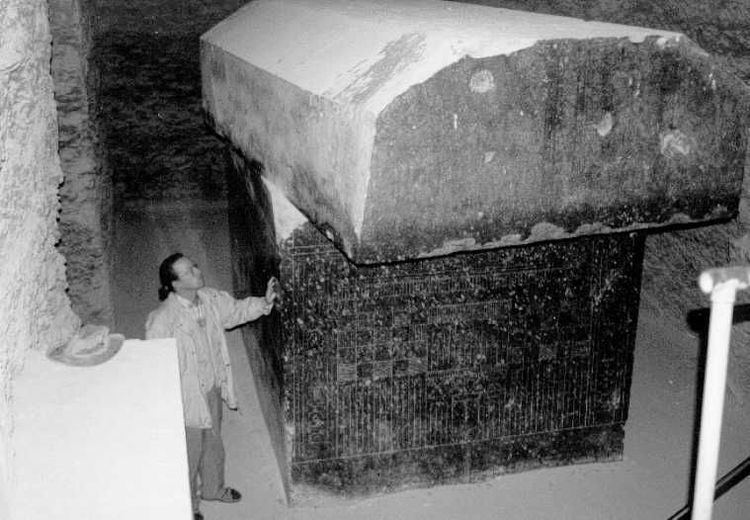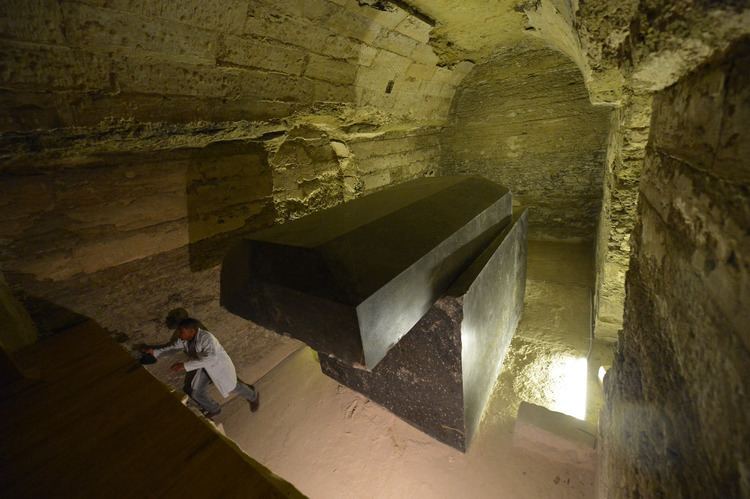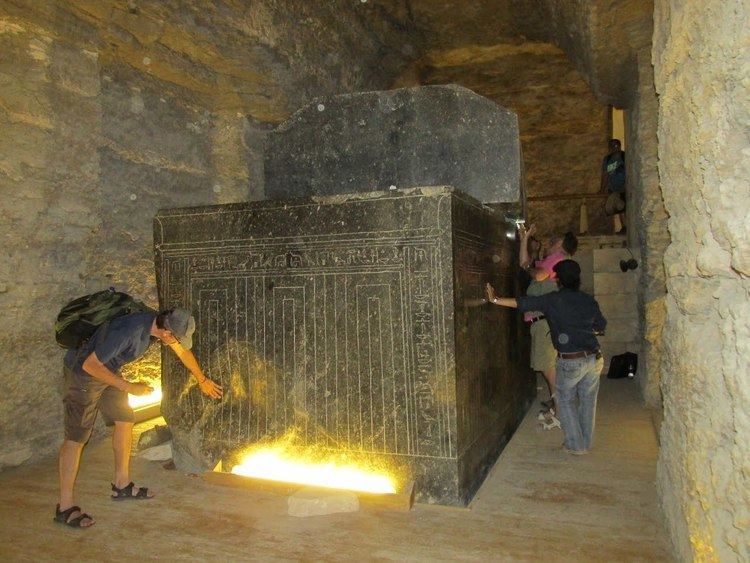 | ||
Similar | ||
Serapeum full movie
A serapeum is a temple or other religious institution dedicated to the syncretic Greco-Egyptian deity Serapis, who combined aspects of Osiris and Apis in a humanized form that was accepted by the Ptolemaic Greeks of Alexandria. There were several such religious centers, each of which was a serapeion (Greek: Σεραπεῖον) or, in its Latinized form, a serapeum.
Contents
- Serapeum full movie
- Egypt underground the enigmatic serapeum of saqqara
- Alexandria
- Destruction of the Alexandrian Serapeum
- Canopus
- Regio tertia
- Campus Martius
- Quirinal Hill
- Hadrians Villa
- Ostia antica
- Pozzuoli
- Pergamon
- Ephesus
- Miletus
- References
Egypt underground the enigmatic serapeum of saqqara
Alexandria
31°10′55″N 29°53′49″E

The Serapeum of Alexandria in the Ptolemaic Kingdom was a ancient Greek temple built by Ptolemy III Euergetes (reigned 246–222 BCE) and dedicated to Serapis, who was made the protector of Alexandria. By all detailed accounts, the Serapeum was the largest and most magnificent of all temples in the Greek quarter of Alexandria. Besides the image of the god, the temple precinct housed an offshoot collection of the great Library of Alexandria. The geographer Strabo tells that this stood in the west of the city. Nothing now remains above ground.

Excavations at the site of the column of Diocletian in 1944 yielded the foundation deposits of the Serapeion. These are two sets of ten plaques, one each of gold, silver, bronze, Egyptian faience, sun-dried Nile mud, and five of opaque glass. The inscription that Ptolemy III Euergetes built the Serapeion, in Greek and Egyptian, marks all plaques; evidence suggests that Parmeniskos was assigned as architect. The foundation deposits of a temple dedicated to Harpocrates from the reign of Ptolemy IV Philopator were also found within the enclosure walls. Subterranean galleries beneath the temple were most probably the site of the mysteries of Serapis. In 1895, a black diorite statue representing Serapis in his Apis bull incarnation with the sun disk between his horns was found at the site; an inscription dates it to the reign of Hadrian (117-38).
Destruction of the Alexandrian Serapeum

The Serapeum in Alexandria was destroyed by a Christian mob or Roman soldiers in 391 (although the date is debated). Several conflicting accounts for the context of the destruction of the Serapeum exist.

According to early Christian sources, bishop Pope Theophilus of Alexandria was the Nicene patriarch when the decrees of emperor Theodosius I forbade public observances of any rites but Christian. Theodosius I had progressively made (year 389) the sacred feasts of other faiths into workdays, forbidden public sacrifices, closed temples, and colluded in acts of local violence by Christians against major cult sites. The decree promulgated in 391 that "no one is to go to the sanctuaries, [or] walk through the temples" resulted in the abandonment of many temples throughout the Empire, which set the stage for widespread practice of converting or replacing these sites with Christian churches.

In Alexandria, Bishop Theophilus obtained legal authority over one such forcibly abandoned temple of Dionysus, which he intended to turn into a church. During the renovations, the contents of subterranean spaces ("secret caverns" in the Christian sources) were uncovered and profaned, which allegedly incited crowds of non-Christians to seek revenge. The Christians retaliated, as Theophilus withdrew, causing the pagans to retreat into the Serapeum, still the most imposing of the city's remaining sanctuaries, and to barricade themselves inside, taking captured Christians with them. These sources report that the captives were forced to offer sacrifices to the banned deities, and that those who refused were tortured (their shins broken) and ultimately cast into caves that had been built for blood sacrifices. The trapped pagans plundered the Serapeum (Rufinus & MacMullen 1984).
A letter was sent by Theodosius to Theophilus, asking him to grant the offending pagans pardon and calling for the destruction of all pagan images, suggesting that these were at the origin of the commotion. Consequently, the Serapeum was levelled by Roman soldiers and monks called in from the desert, as were the buildings dedicated to the Egyptian god Canopus. The wave of destruction of non-Christian idols spread throughout Egypt in the following weeks, as documented by a marginal illustration on papyrus from a world chronicle written in Alexandria in the early 5th century, which shows Theophilus in triumph (illustration, above left); the cult image of Serapis, crowned with the modius, is visible within the temple at the bottom (MacMullen 1984).
A slightly different version of this account of the destruction of the Serapeum begins with Bishop Theophilus closing down a Mithraeum, rather than the temple of Dionysus, but details of the ensuing profanation and insinuation of human sacrifices substantially agree.
An alternate account of the incident is found in writings by Eunapius, the pagan historian of later Neoplatonism. Here, an unprovoked Christian mob successfully used military-like tactics to destroy the Serapeum and steal anything that may have survived the attack. According to Eunapius, the remains of criminals and slaves, who had been occupying the Serapeum at the time of the attack, were appropriated by non-Christians, placed in (surviving) pagan temples, and venerated as martyrs (Turcan, 1996).
Whichever the cause, the destruction of the Serapeum, described by Christian writers Tyrannius Rufinus and Sozomen, was but the most spectacular of such conflicts, according to Peter Brown. Several other ancient and modern authors, instead, have interpreted the destruction of the Serapeum in Alexandria as representative of the triumph of Christianity and an example of the attitude of the Christians towards pagans. However, Peter Brown frames it against a long-term backdrop of frequent mob violence in the city, where the Greek and Jewish quarters had fought during four hundred years, since the 1st century BCE. Also, Eusebius mentions street-fighting in Alexandria between Christians and non-Christians, occurring as early as 249. There is evidence that non-Christians had taken part in citywide struggles both for and against Athanasius of Alexandria in 341 and 356. Similar accounts are found in the writings of Socrates of Constantinople. R. McMullan further reports that, in 363 (almost 30 years earlier), George of Cappadocia was killed for his repeated acts of pointed outrage, insult, and pillage of the most sacred treasures of the city.
Whatever the prior events, the Serapeum of Alexandria was not rebuilt.
Canopus
Another Serapeum was located at Canopus, in the Nile Delta near Alexandria. This sanctuary, dedicated to Isis and her consort Serapis, became one of the most famous cult centers of the Ptolemaic Kingdom and Roman Egypt. Its festivals and rites were so popular that the site became an architectural model for sanctuaries to the Egyptian gods throughout the Roman Empire.
At this Graeco-Roman site, a sacred temenos enclosed the temple dedicated to the gods, which was located behind a propylaea or peristyle court. Auxiliary shrines dedicated to other, less universal, Egyptian deities could be found here as well, including those dedicated to Anubis (Hermanubis), Hermes Trismegistus, the syncretism of Thoth and Hermes, Harpocrates, and others. Ritual complexes dedicated to Isis were often built around a well or a spring, which was meant to represent the miraculous annual inundation of the Nile. This was also the case in sanctuaries devoted to the Egyptian gods in Roman-era Delos, where a central basin provided the water element central in the rites of Isis.
Regio tertia
The Regio III within the city of Rome was named Isis et Serapis because it contained a temple dedicated to the two Egyptian deities. The structure, originally dedicated to Isis alone, was built by Quintus Caecilius Metellus Pius in the first half of the 1st century BCE to celebrate his father's victory over Jugurtha.
The complex, of which only parts of the foundations remain, was originally terraced; during the Flavian dynasty, it underwent major renovations, and the cult of Serapis was associated to that of Isis. The temple was finally demolished during the 6th century.
Campus Martius
This temple, dedicated to Isis and Serapis, was first dedicated by the triumvirs in 43 BCE in Rome. However, due to later tensions between Octavian (later Augustus Caesar) and Marc Antony, the temple was not built. Following the Battle at Actium, Augustus banned the religion from within the pomerium of Rome altogether. The temple was finally built by Gaius Caligula on the area known as Campus Martius, between the Saepta Julia and the temple of Minerva c. 37-41 CE.
The Serapeum, 240 m long and 60 m wide, was divided in three sections: a rectangular area could be accessed first by walking under monumental arches; an open square, adorned with red granite obelisks brought to the city during the 1st century and erected in couples, followed. The centre of the square was likely occupied by the temple dedicated to Isis, while the third section, a semicircular exedra with an apse presumably hosted the altar dedicated to Serapis. Fragments of the obelisks, some quite large, have been found around the current church of Santa Maria sopra Minerva; some archaeologists have proposed that the obelisk facing the Pantheon (see picture) may have been repositioned from the temple to its current location.
The building was destroyed in the great fire of the year 80 CE and rebuilt by Domitian; further renovation was initiated by Hadrian, while Septimius Severus ordered the necessary upkeep of the temple's structure. Written records attest to the Serapeum's existence and ritual activity until the 5th century.
Quirinal Hill
The temple built on Quirinal Hill and dedicated to Serapis was, by most surviving accounts, the most sumptuous and architectonically ambitious of those built on the hill; its remains are still visible between Palazzo Colonna and the Pontifical Gregorian University.
The sanctuary, which lay between today's piazza della Pilotta and the large square facing Quirinal Palace, was built by Caracalla on the western slopes of the hill, covering over 13,000 m2 (3.2 acres), as its sides measured 135 m by 98 m. It was composed by a long courtyard (surrounded by a colonnade) and by the ritual area, where statues and obelisks had been erected. Designed to impress its visitors, the temple boasted columns 21.17 m (69 ft 5 in) tall and 2 m (6 ft 7 in) in diameter, visually sitting atop a marble stairway that connected the base of the hill to the sanctuary.
An enormous fragment of entablature, weighing approximately 100 tons and 34 m3 in volume (the largest in Rome), belongs to the original temple, as do the statues of the Nile and the Tiber, moved by Michelangelo to the Capitoline Hill in front of the Senate building.
Hadrian's Villa
Emperor Hadrian (117-138) ordered the construction of a "canopus" in his villa in Tivoli with typical imperial grandeur: an immense rectangular tank representing a canal, 119 m long by 18 m wide was surrounded by porticoes and statues, leading the way to a Serapeum. Protected by a monumental dome, the sanctuary was composed of a public area and a more intimate subterranean part that was dedicated to the chthonic aspect of Serapis.
To mark the inauguration of his temple, Hadrian struck coinage that carry his effigy accompanied by Serapis, upon a dais where two columns support a round canopy. In this manner, the emperor became synnaos, a companion of the god's arcane naos and equal beneficiary of the cult of Serapis at Canopus.
Ostia antica
The Serapeum of Ostia Antica was inaugurated in 127 CE and dedicated to the syncretic cult of Jupiter Serapis.
It is a typical Roman sanctuary, on a raised platform and with a row of columns at the entrance, where a mosaic representing Apis in a typically Egyptian manner can still be seen. From this temple likely came the statue that Bryaxis copied for the Serapeum in Alexandria.
Pozzuoli
The Macellum of Pozzuoli, marketplace or macellum of the Roman city of Puteoli (now known as Pozzuoli) was first excavated in the 18th century, when the discovery of a statue of Serapis led to the building being misidentified as the city's serapeum, the Temple of Serapis. Under that name, the site had considerable influence on early geology as a band of boreholes affecting the three standing columns suggested that the building had been partly below sea level for some period.
Pergamon
Inside Pergamon in Bergama, there is the Temple of Serapis, built for the Egyptian gods in the 2nd century CE and called the Red Basilica (Kızıl Avlu in Turkish) by locals. This is a basilica-shaped building constructed under the reign of Hadrian. It consists of a main building and two round towers. In the Christian New Testament, the Church at Pergamon, inside the main building of the Red Basilica, is listed as one of the Seven Churches to which the Book of Revelation was addressed (Revelation 2:12).
Ephesus
Another Serapeum was in Ephesus, which is near present-day Selçuk, İzmir Province, Turkey. The temple is located behind the Library of Celsus. This Egyptian temple was turned into a Christian church.
Miletus
This temple was built in the 3rd century BCE near the south agora of Miletus and also it was restored by Emperor Julius Aurelius (270-75 CE)
